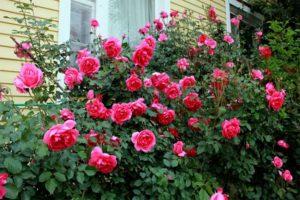Description of varieties of indoor roses, how to grow and care at home in a pot
Indoor roses are in demand by almost every gardener, they are called queens of flowers. Dwarf varieties are capricious and require proper care. They are bought in pots or bred at home. In order for a rose to develop safely, to bloom, it is necessary to familiarize yourself with all the nuances of its cultivation and care.
Rose varieties suitable for home growing
Almost any varieties and hybrids of roses can be grown indoors. Low-growing plants are used for pot culture. They have a compact bush shape, abundant, long flowering. Even inexperienced gardeners can grow a homemade rose. The main thing is to properly plant and care for.
Baby Masquerade
Indoor rose variety Baby Masquerade is famous for its simple growing conditions. The flowers are pinkish-white, sometimes with a lemon tinge. As they bloom, they change color to coral, then turn red. By the end of the pollen, they become crimson. The height of the bush is approximately 40 cm.
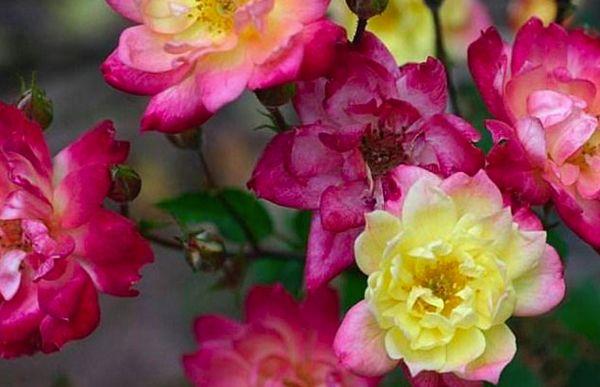
Angela Rippon
The decorative variety belongs to miniature Patio roses of a pale salmon color. Flowers smell strong, emit a romantic scent. The height of the plant is 30 cm. The species is unpretentious in care, but loves lighted places.
Easter Morning
The variety is famous for its creamy white flowers of small size, about 3-4 cm.The bushes are densely double, emit a faint aroma. The plant grows up to 20-25 centimeters high, well-branched. Leaves are dark green, leathery, slightly glossy. The bud is yellow and sharp.
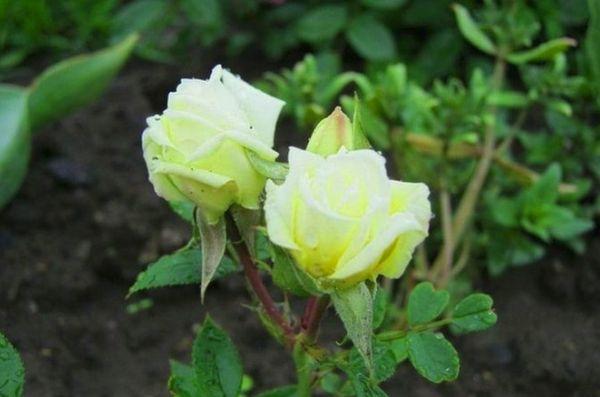
Fire Princesses
The hybrid variety Fire Princess is distinguished by pure red petals with golden yellow stamens. Leaves are glossy emerald. The bush grows up to 50 cm high, the stems are scarlet, strong. Medium early flowering variety.
Hummingbird
Hummingbird roses are famous for their golden yellow cupped flowers 4 cm in diameter, pointed-oval buds. One bud has 20-25 petals. The flowers give off a tea scent. The bushes are sprawling, dense, up to 35 cm high. The leaves are leathery, shiny. The plant blooms profusely for a long time.
Yellow Dol
Small shrub roses, inflorescences are arranged in 3-4 pieces, collected in a brush. Flowers emit a fragrant smell, they are terry. One bud has up to 50 inflorescences, lemon-yellow color. The bush grows up to 25 cm high.

Stars and Stripes
Variegated flowers of a red and white hue, great for landscaping an apartment. The height of the bush is about 60 centimeters. The aroma is sweet, the pollen is continuous. The flower size is 8 cm.
Green Ice
Rosaceous bushes give snow-white flowers up to 3.5 cm in diameter. The height of the bushes is 60 cm, the leaves are dark green with a glossy shine. The plant blooms from June to July, the smell is sweet, reminiscent of morning freshness.
What to look for when buying a flower?
Before buying a flower, it is important to pay attention to the quality of the stems, they should be considered carefully. We'll have to remove the gift bag. The stems should be green with no black spots. Also make sure that the leaves do not fall off, the color is consistent with the variety standard. The foliage should be dark green, lush, free of pests and fungi.
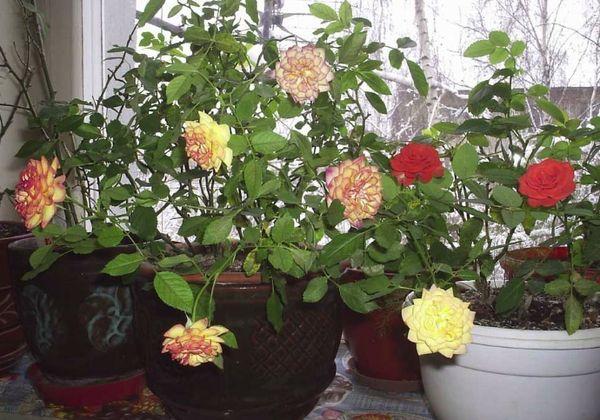
Home rose care
A rose at home should be grown according to the following rules:
- allocate enough space in the chosen place for free growth;
- ensure the optimal level of humidity in the room, the temperature is 22-25 degrees Celsius;
- follow the rules for moistening the earth;
- process the soil and the plant itself on time;
- to carry out the prevention of diseases, pests.
Competently organized care, wintering, will allow the plant to open up in March.
What to do right after purchase?
You can buy a room rose in garden stores, in the market or online. The latter method is less desirable, since there is a risk of getting the wrong variety or damaged seedling. Make the purchase from trusted sellers, or in a store with a good reputation.
After purchasing a flower, upon arrival home, perform the actions described below.
- If the flower has a packing wrap, remove it.
- Remove withered leaves with scissors or pruning shears, and remove all dry shoots.
- Cut off all the buds, flowers. The procedure is necessary to stimulate further flowering of the bush. The plant should not waste energy on pollen, because after, it may die.
- Inspect how many bushes are in the pot. There must be 1 copy in it, otherwise the plant will be weak. If there are several bushes in the pot, plant them in other places.
After transplanting the bushes, treat them with a remedy for harmful beetles. Fitoverm, an antifungal agent Fitosporin, is widely used.
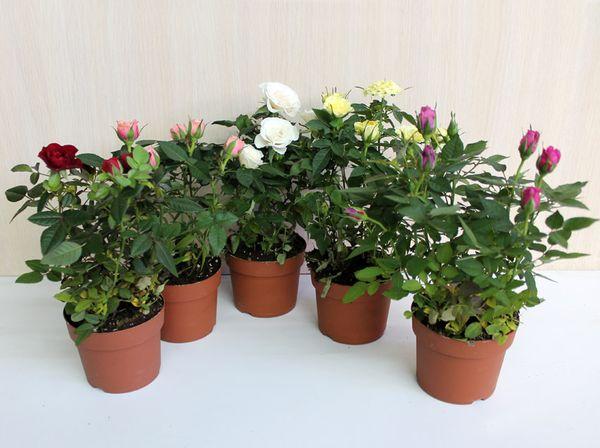
Pot and soil
The soil in which the plant is contained when sold is usually unsuitable for further growth and development. The flower must be transplanted into a pot, 2-3 cm larger in diameter than the previous container. The substrate is prepared from 1 part of sod land, 1 part of humus, ¼ part of coarse sand. Purchased flower primer is also used. The main thing is that the soil is nutritious, drainage from expanded clay with a height of 2 cm is required.
Lighting and temperature
Indoor roses prefer to be kept in a lighted place. This is required for the bush to be healthy and strong. It is advisable to plant the selected variety on a south-facing windowsill. In winter, additionally highlight the bush. It is necessary to grow flowers at temperatures ranging from 18 to 22 degrees.
In the summer, transfer the flower to the garden so that it is saturated with oxygen. At other times of the year, systematically ventilate the culture, protecting it from drafts.
Watering and humidity
Watering is necessary with settled water, room temperature. If it is icy, it will harm the flower. Periodically moisten the soil with a sprayer in the heat and winter. If the plant is located next to a heating device, place the pot in a pallet pre-filled with wet expanded clay.
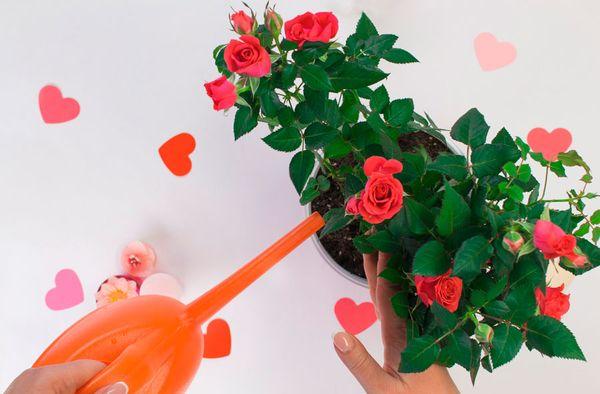
Fertilizers and feeding
You need to feed only during budding, pollen. The procedure is carried out every 10 days, using a feed for flowering crops. By the end of pollen, which occurs at the end of August or September, stop fertilizing the soil.
Transfer
It is necessary to transplant a room rose from a pot into a pot or into the soil in accordance with the steps below.
- When transplanting a rose at home, carefully remove it from the old pot, taking it in the right place with an earthen lump.
- Examine the rhizome carefully. If the roots are thin, outwardly similar to dark hairs, decayed or dried out, this indicates the imminent death of the bush. You can save the rose by cutting the cuttings, which are then given by rooting. If the root system is healthy, the roots will be pale yellow or deep white, dense and thin, like a wire. When some of the roots are dry or rotten, they are removed.
- For planting, a flower pot is taken, a drainage layer is made at the bottom using expanded clay. Use a potting potting mix made specifically for roses. Cover the drainage layer with a layer of earth, tamp it a little.
- Place a bush together with an earthen clod in a container. Fill all voids with fresh substrate, periodically tamping the soil. The rose should not dangle in the container, but be securely fixed.
- For irrigation, use filtered water, it should not be ice cold, but slightly warm.
- Place the container with the flower on a lighted windowsill.
In winter, use ultraviolet paws for additional illumination of the flower.
Pruning
After pollen, the rose needs to be pruned. Each branch after the procedure should have 4-5 buds. If you ignore pruning, there will be no abundant flowering.
How to prepare a rose for winter
In order for the rose to please with abundant flowering, you should give it a rest for the winter. For this, the branches are cut 10 cm in length, the leaves are left. The flower is placed in a cool room with an air temperature of 10 degrees. Do not put a rose next to heating appliances. Stop fertilizing, water the flower once a week.
Diseases and harmful beetles
If you properly care for a home rose, it is not afraid of diseases and attacks of harmful beetles. The appearance of powdery mildew is not excluded. The disease manifests itself as a whitish bloom on the bush. Then carry out the treatment of the flower with Fundazol. From harmful insects, spider mites and aphids attack the rose.
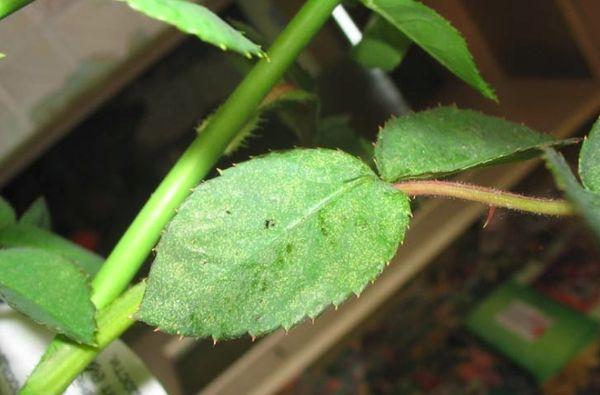
It is necessary to discard the affected leaves, then rinse the culture under running water. The procedure will help flush out the mites. When the rose is dry, treat it with bug repellent. Pour boiling water over the pallets so that the remaining pests die out. Put a trash bag on a plant treated with anti-tick preparations and tie tightly. Then a steam room is formed, all pests die.
Reproduction
To increase the number of indoor roses, use a vegetative propagation method. In the form of planting material, use the branches left after cutting. Their length should not be more than 15 cm, there are at least 4 buds on the stem. In order for the cuttings to take root, place them in water with a dissolved activated carbon tablet, a combination of sand and peat. You can also help them take root by treating the branches with Kornevin or tincture of willow branches. The root system will form in 2 weeks. After that, the multiplied seedlings are transplanted in containers.

